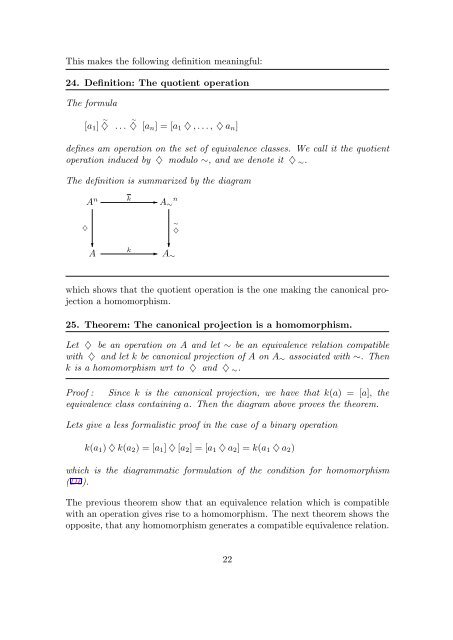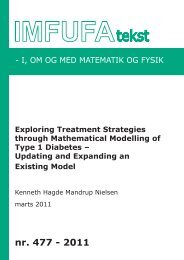ABSTRACT ALGEBRAIC STRUCTURES OPERATIONS AND ...
ABSTRACT ALGEBRAIC STRUCTURES OPERATIONS AND ...
ABSTRACT ALGEBRAIC STRUCTURES OPERATIONS AND ...
Create successful ePaper yourself
Turn your PDF publications into a flip-book with our unique Google optimized e-Paper software.
This makes the following definition meaningful:<br />
24. Definition: The quotient operation<br />
The formula<br />
[a1] ♢ ∼<br />
. . . ♢ ∼<br />
[an] = [a1 ♢ , . . . , ♢ an]<br />
defines am operation on the set of equivalence classes. We call it the quotient<br />
operation induced by ♢ modulo ∼, and we denote it ♢ ∼.<br />
The definition is summarized by the diagram<br />
♢<br />
A n k ✲ A∼ n<br />
∼<br />
♢<br />
❄ ❄<br />
A<br />
k ✲ A∼<br />
which shows that the quotient operation is the one making the canonical projection<br />
a homomorphism.<br />
25. Theorem: The canonical projection is a homomorphism.<br />
Let ♢ be an operation on A and let ∼ be an equivalence relation compatible<br />
with ♢ and let k be canonical projection of A on A∼ associated with ∼. Then<br />
k is a homomorphism wrt to ♢ and ♢ ∼.<br />
Proof : Since k is the canonical projection, we have that k(a) = [a], the<br />
equivalence class containing a. Then the diagram above proves the theorem.<br />
Lets give a less formalistic proof in the case of a binary operation<br />
k(a1) ♢ k(a2) = [a1] ♢ [a2] = [a1 ♢ a2] = k(a1 ♢ a2)<br />
which is the diagrammatic formulation of the condition for homomorphism<br />
(D6).<br />
The previous theorem show that an equivalence relation which is compatible<br />
with an operation gives rise to a homomorphism. The next theorem shows the<br />
opposite, that any homomorphism generates a compatible equivalence relation.<br />
22
















